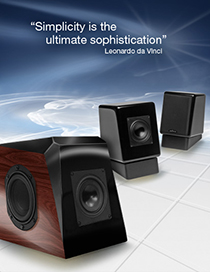ClairAudient 1+1 V5Personal Reference Monitors
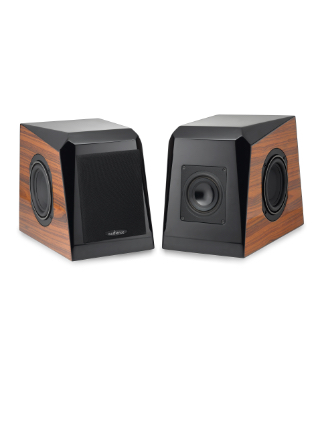
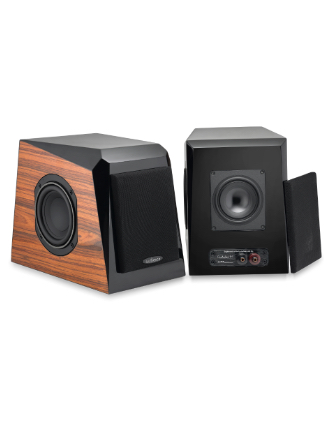
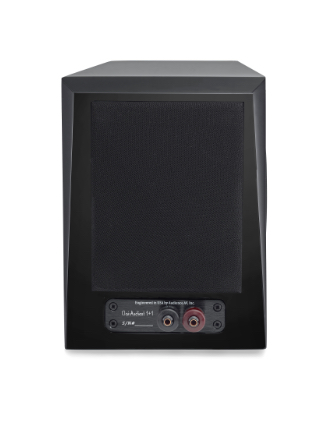
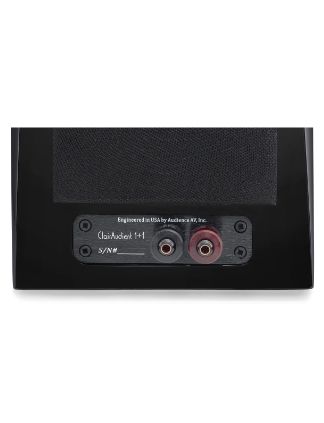




The 1+1 is the most unique small footprint loudspeaker in the world. It features a wideband driver eliminating the need for desperate drivers and crossovers. The 1+1 V5 measures flat from 55Hz up to 22Khz without the use of a dedicated tweeter and associated crossover. Consequently, transition at the most critical frequency range, from mid to high, is entirely smooth and supremely coherent. The 1+1 V5 is a bi-pole design, which expands the soundstage, extends low frequency, and increases power handling. There are active full range drivers, in phase, on the front and rear baffles, complemented by passive radiators on each side. The jewel-like enclosure is a joy to look at and will fit into any room where space is at a premium and high-quality sound is desired.
The A3S2-16 drivers employed in the 1+1 V5 are a dual gap motor design with ultra long-throw excursion providing surprising SPL levels with big dynamic range. Don’t let their small size fool you. They are exceptionally resolute at low volumes and will effortlessly deliver the full emotional slam of your most dynamic music. The 1+1 V5 personal reference monitors offer State of the Art near field listening (rated by The Absolute Sound Magazine).
Models of 1+1 over the years include:
1+1 V1
2012 - World debut at THE Show Newport Beach, CA.
*1+1-i was introduced in 2016 and is a variation of the 1+1 V1 including upgraded passive radiators.
*1+1 ns was introduced in 2021 and is a variation of the 1+1 V1 including upgraded passive radiators and baffle-step reduction technology.
1+1 V2
2015 - The 1+1 loudspeaker released Version (V2) which includes which includes new A3S2-16 drivers. These drivers are greatly improved due to:
More powerful motor resulting from the use of higher quality steel in making the magnets.
Higher tolerance fit of motor to basket assembly connection resulting from re-tooling of the basket and CNC machining of the motor structure.
Implementation of Audience proprietary OCC copper tensile wires.
Elimination of jumper wires and 10 solder connections resulting from the conversion of dual 8-ohm voice coil design to a single 16-ohm voice coil.
1+1 V2+
Introduced at CES 2016, the 1+1 debuted in the V2+ configuration, which included the new A3S2-16 drivers plus beautiful solder-free Tellurium spring tension binding posts and internal wiring with new Audience Au24 SX wire. The sonic improvements of the V2+ design is nothing short of stunning. These improvements put the loudspeakers into a different class. They are more "high end". They sound like larger and more capable loudspeakers with noticeably more finesse, dynamics and resolution.
1+1 V3
August, 2018 - The 1+1 loudspeaker released Version (V3) which includes the best of the V2+ in addition to some great new technologies. The improvements of the V3 loudspeakers are very significant resulting from the implementation of improved voice coil technology with faster rise time and greater control of the driver. Additionally, the V3 loudspeaker internal wiring includes the metallurgic improvements represented in the new Audience flagship frontRow cables wiring. The end result of these improvements is not subtle. The V3 loudspeakers are notably better in just about every aspect. The resolution is greater, and the background is quieter resulting in a dramatically more palpable and tonally rich presentation. Dynamics and sound staging are also improved. The combination of these new features is not just an upgrade ... it warrants a whole new model version.
1+1 V4
July, 2021 - The improvements of the V4 loudspeakers are very significant resulting from the implementation of improved passive radiators and top of the line KLEI ultra-low mass pure copper binding posts.
1+1 V5
June, 2022 - The improvements of the V5 loudspeakers result in peak performance from the implementation of an enhanced baffle-step reduction technology. Frequency response in the high range as well as upper bass is noticeably smoother. The 1+1 V5 will now play louder than ever before with better bass and without the risk of damaging drivers.
Reviews can be read here.
Previous versions of 1+1 speakers can be upgraded.
Call 1-800-565-4390
Email: info@audience-av.com
Click Image to Read Quote:
Loudspeaker FAQ
What is a bi-pole loudspeaker system?
A bi-pole loudspeaker system is one with drivers front and rear operating in phase. Some bi-pole designs are designed with different drivers front and rear and there are some in which rear passive radiators, used as tuning devices, only act as a bi-pole at a narrow range of frequencies.
What is phase?
The term “phase,” as it is used in audio, refers the movement of the speaker cone or other transducer in response to a signal. When drivers simultaneously move in the same direction in response to a given signal, they are said to be in phase and when they move in the opposite directions they are said to be out of phase. In phase drivers provide a fuller and richer sound and bi-pole designs express that quality exceptionally well.
What is impedance?
Impedance can be thought of as the equivalent of resistance or push-back (impediment) to an electrical signal. It is a measure of the resistance in a speaker that occurs when music in your system plays. As the music changes impedance also changes with the frequency of the musical signal. Impedance is expressed in ohms. Most speaker systems are designed as fixed 4, 8, or 16 ohm devices. Some Audience ClairAudient speaker systems are available in several impedance ratings to meet your needs.
What is loudspeaker efficiency?
Loudspeaker efficiency is a measure of acoustic output when a precise signal is applied to it. This is generally expressed, in engineering terms, as an equation of X dB @ Y volts. That equation tells you how easily your speaker can be powered by an amplifier. ClairAudient loudspeakers have an efficiency ratings ranging from 85 dB to 99 db and can be used with a wide range of amplifiers.
What is sensitivity?
Sensitivity is a specification that relates to the efficiency of a speaker. Sensitivity is the sound pressure level (SPL), in a non-reflective environment, measured at 1-meter distance from the front of a loudspeaker produced by 1 watt of power (2.83 rms volts into 8 Ω) into the speaker and is expressed in decibels (dB). A higher sensitivity number means the speaker will require less power to drive it. For example a speaker rated at 99db will require less power than one rated at 95db to achieve the same output volume.
What is transient response?
Transient response is a measure of how quickly a speaker responds to a quick change in a music signal. A crashing cymbal from a quiet background for instance. The faster the response, the more crisply and accurately that sound will be reproduced. A slow response results in a sound that is muddy or less distinct. A driver with a large speaker cone typically has a slower transient response than a driver with a small-diaphragm cone. Since all Audience ClairAudient loudspeakers utilize small-diaphragm drivers the transient response is exceptionally good. (Please see our Technology Section for a complete description of Audience A3S driver.) Good transient response is vital for proper speaker imaging. The leading edge of a signal gives us the ability to locate sounds in space. These “images” are only achieved if they are accurately reproduced.
What is imaging?
Imaging is the ability of a loudspeaker system to accurately place a voice or instrument into the listening area much like a live musical event. A speaker system that can recreate the realism of a performance in horizontal and vertical positions such that you perceive it as “being there” is said to image well. Audience ClairAudient speakers are known for very precise imaging.
How should my loudspeakers be placed?
Most every listening environment is unique and is an integral part of the music playback system. Every room is different in size and shape and contains different furnishings. Careful placement can make big improvements in how sound is reproduced into the room. Conversely poor placement can reduce even the finest speaker system to mediocre sound. Audience ClairAudient Loudspeaker Systems can perform very well in rooms that hinder the performance of conventional designs. They are said to be “room friendly”. ClairAudient loudspeakers perform very well in a variety of placements. The more conventional sweet spot set up for one or two listeners works by placing ClairAudient speakers angled directly at the listener. However, ClairAudient speakers are unusual in that a SweetSpace sound field arrangement is also possible whereby a more holographic sound staging is cast into the room. The SweetSpace arrangement is accomplished by towing the speakers in at 45 degrees. In this configuration numerous people can enjoy a realistic sound stage simultaneously much like an actual live performance. Additionally, by moving speakers closer to, or further away from, the walls behind the speakers the bass response can be adjusted to a greater or lesser degree. ClairAudient loudspeakers continue to image well close to the back wall, whereas a great many speakers will not. The depth of the sound field is also affected by the distance speakers are from the wall behind them. Speakers placed farther from the wall exhibit a deeper soundstage, front to back. ClairAudient loudspeakers are unique in that their exceptional sound can be enjoyed with extraordinary placement flexibility.
What kind of loudspeaker cables and interconnects should I use?
The simple answer to this question is “use the best cables and power cords that you can get”. Interconnects, speaker cables and power cords are the arteries of an audio system carrying the music signal much like the arteries of a human body. The health or quality of a system is very much dependant on the quality of the arteries that connect each component or your sound system. There are those who argue that cables do not make any difference in sound and support their assertions by technical measurements. Irrespective of this technical hyperbole, differences in the quality of reproduced sound using various cables can easily be demonstrated in any high quality sound system. There is no measuring device ever made by man that is more perceptive and discriminating than the human ears, brain and nervous system and the differences in cables is audible. In addition price does not necessarily equate to quality. Some cable manufacturers spend more on marketing than on manufacturing quality goods. We urge you to use your own judgment by listening evaluations, obtaining the assistance of a reputable audio dealer, manufacturer or an experienced audiophile friend. Audience manufactures various types of cables to meet your needs and they are rated as some of the finest available bar none. Please see the Cable Section of this site to learn more about Audience cables.
Is this true that cabinet design and materials are important to the sound quality of a loudspeaker?
Many people view a speaker cabinet, also referred to as an “enclosure”, simply as a cosmetic design. This is very far from the real purpose of a well designed loudspeaker enclosure. While cosmetics, fit and finish of a speaker cabinet are very important, the design and execution of the enclosure plays as key role in the performance of a speaker system. A well designed speaker enclosure is rigid to control the acoustic energy in a predicable way and is crucial to how the sound is directed into the room. It is a major factor in the accuracy and power of bass response and much more. Audience ClairAudient speaker enclosures are as advanced in design and assembly as the speaker components and wiring inside them. The quality of materials, method of constructions and finish of Audience loudspeaker systems are the finest available and are handcrafted with great care.
How much power do I need to get the most from my loudspeakers?
The amount of amplifier power you will need depends on several considerations: What kind of music you listen to? How loud do you listen? What is the size of your room? What is the efficiency rating of your speakers? Without getting into all the possible variations, it is best to use an amplifier that has enough reserve power to produce your music without distortion or compression of the dynamic peaks. The minimum recommended power for good performance should be listed in the specifications of the speaker. Audience ClairAudient speakers are relatively efficient and as such huge amplifiers are not necessarily required for excellent performance. The larger your room and the degree of loudness that you prefer will determine the amount of power that will be needed from a power amplifier. Contact Audience for more information or visit our Technology Section for additional information on matching your components.
What are crossovers and why are there no crossover in Audience ClairAudient loudspeakers?
Crossovers are filter networks used to direct various audio frequencies in a conventional speaker system comprised of differing drivers; tweeters, mid range drivers and woofers. By their nature crossover networks are one of the main compromises in speaker designs due to the variety of problems they introduce which include phase distortion and other audibly negative artifacts. From the inception of Audience the vision was to build a loudspeaker that was free from the limitations of conventional loudspeaker design. The only way around disparate drivers and crossover networks is to use “full range” loudspeaker drivers that are capable of reproducing the complete audible frequency range of music. Audience developed a unique and technically advanced, ultra high resolution A3S full-range driver so that the incoming music signal is not redirected, filtered or delayed in any way. The result is exceptional transparency, powerful dynamics and exceedingly natural transition from low to high frequencies. Sound reproduced from ClairAudient loudspeakers is more natural and coherent in every way than any other loudspeaker ever made.
| Model | 1+1 V5 |
| Frequency Response | 55 to 20kHz, +/- 3 dB F3 55Hz F6 50Hz F10 46Hz |
| Impedance | 8 ohms |
| Sensitivity | 87 dB, in room - 1W/1m |
| Dimensions | 8" high 9.75" deep 6" wide |
| Weight | 7 lbs. 4oz. |
| Recommended Amplifier Power | 15 to 60 watts |
| System Principal | Dual full-range drivers in Bipole configuration with two side firing Passive Radiators. |
| Recommended Stand Height | 28 inches |
| Input Terminals | 5-way binding posts |
| Measurements | Measurements |
| Features | Features |
The 1+1 owner's manual in PDF format can be downloaded here.












